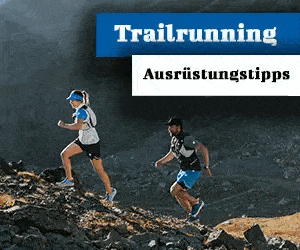The Swiss expedition team headed by Nicolas Hojac, Stephan Siegrist and Lukas Hinterberger make first ascents in Patagonia. Among other things, they are the first to climb the north-east wall of the Cerro Cachet on a varied and challenging mixed climbing route with a difficulty of M7 +.
An experience report by Lukas Hinterberger
When I suddenly had Stephan Siegrist on the phone in the middle of last year and he asked me if I had time in November to go on an expedition to Patagonia, I thought he was going to rock me. After all, Stephan is one of the most experienced alpinists in the world and one of the most famous mountaineers in Switzerland. An absolute Patagonia and expedition expert, and this Stephan asked me if I would come with me. That sounded like winning the lottery, I hit straight away. Patagonia was at the top of my bucket list anyway and I had no concrete travel plans for the fall. My buddy Nico Hojac had probably brought me into play as a climbing partner, the two know each other from their supplier, Mammut. And Nico and I were together in the SAC expedition squad, had climbed several peaks together and had been on expeditions together in China and Pakistan.
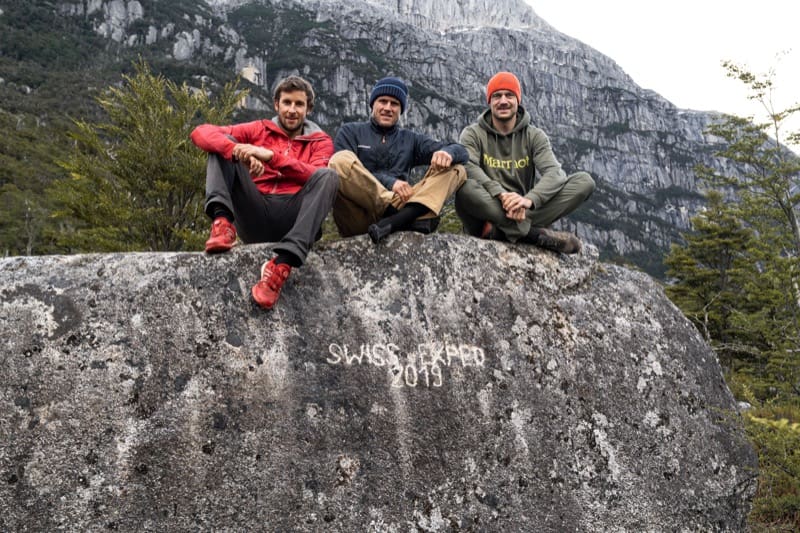
Stephan and Nico had done a lot of research beforehand and it was clear that northern Patagonia is far from being as accessible as the melting pot of the global climbing scene, the area around El Chaltén - the starting point for the famous routes on Cerro Torre, Torre Egger, Cerro Standhardt or Fitz Roy.
On November 3rd we went from Zurich to Santiago de Chile, from there we went straight to Balmaceda and Coyhiache. William Clark - yes, his real name - a long-time Argentinian friend and expedition partner of Stef, was waiting for us and we went straight to check out the complete equipment. William had Steph's climbing gear, tents, stoves, etc. deposited in Patagonia with him, but there was still a lot to get.
Off to the hardware store
Our first stop was the Coyhiache hardware store. It's bizarre - I've been to Chile for less than 24 hours, the first time south of the equator and what do I do first: I go to the hardware store with three friends. For the base camp we still needed tarpaulins, wire, saws, saucepans, denatured alcohol and a lot more. Then we went to the supermarket and packed with three full shopping carts with food for our six week trip and $ 900 less in our pockets, we had pretty much everything we needed.
Off to the south with 500 kilograms of equipment
The next day William drove us to Puerto Bertrand with his pick-up, 450 kilometers south of Coyhiache. Almost 500 kilograms of equipment in the loading area and five people in the driver's cabin forced the car to its knees, but it held out. Puerto Bertrand welcomed us with blue skies, but also with storm gusts of 150 km / h, which caused the water on the lake to fly. A crossing over Lago Plomo, from where the trail towards Basecamp and Nef glacier should start, was out of the question. We had to weather, as Tobias says. Tobi is a friend of Steph, a journalist from Hamburg who has already traveled to Kashmir with Steph. He was supposed to accompany us to Basecamp for a few days and return after about two weeks.
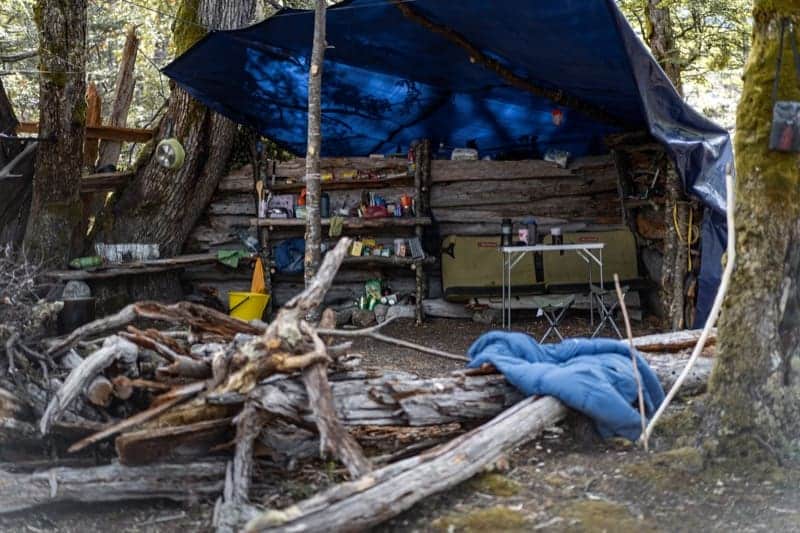
Walking through bushes and swamps
Only after two days we were able to take a small boat from our gauchos Hector and Don Ramon across Lake Plomo to the ranch. There was the starting point for our trip 'Into the Wild'. This was followed by a two-and-a-half day hike through bushes and swamps, over some rocky outcrops and along the banks of the Rio Soler. We loaded the food and equipment onto six pack horses owned by Hector, Don Ramon and his brother Luis, who brought all the material to the last piece of forest in the valley. We set up our base camp there. We built a small, open forest hut out of the dead wood, wire and a solid tarpaulin - our kitchen, dining area and chill-out lounge in one.
The first two weeks we had to stay in our tents and camp - the Patagonian weather showed its diva-like, rainy side. We passed the time with fretboard sessions, playing chess, reading or building small protective walls against the impending flood from the nearby river. But actually we only wanted one thing: finally mountaineering.
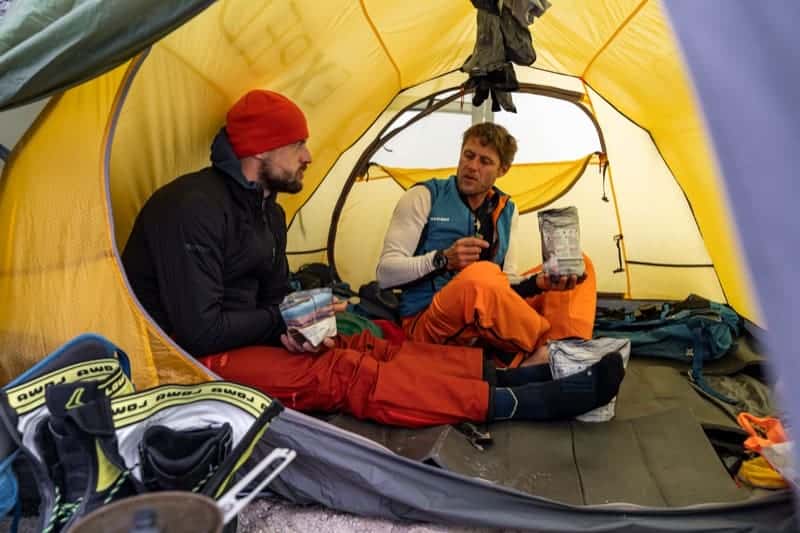
When the weather improved for a day, we seized the opportunity and set off. 20 kilometers and almost 2500 meters later we stood on the summit of the 2799 meter high Cerro Largo. After nine hours of arduous ascent on skis (which Robert Jasper and his team in Chile had kindly given us) over the Nef glacier, we reached the summit mushroom and finally climbed to the peak through almost vertical rime ice at dusk. In the last few meters we felt an intense feeling of happiness, it was an indescribable moment. The inland ice around us and in the far distance the Pacific shimmered golden in the evening sun. It was the first Patagonian summit for Nico and me - what a day.
"During the last few meters, we felt an intense feeling of happiness, it was an indescribable moment."
Our view was not only to the west to the Pacific, on the other side the striking northeast face of the Cerro Cachet caught our eye. The mountain, which is around 2600 meters high, had only been climbed one more time since it was first climbed in 1971 by New Zealand climbers, both times via the rather simple ramp from the inland ice. But there has not yet been an ascent over the vertical northeast face - our challenge for the next stable weather window.
Dead tired, hungry and still overjoyed
But as beautiful as the view and the feelings of happiness on the summit were, suddenly we click - the arduous descent was still ahead of us. We only had mountain boots and to ski with them over the wind-eroded, partly bare glacier ice was a real ordeal. Only after 16 hours of exertion did we reach our base camp - dead tired, hungry, but also overjoyed. During the midnight feast around the campfire, we really realized what we had achieved - and so we had a can of tuna with the noodles to celebrate the day.
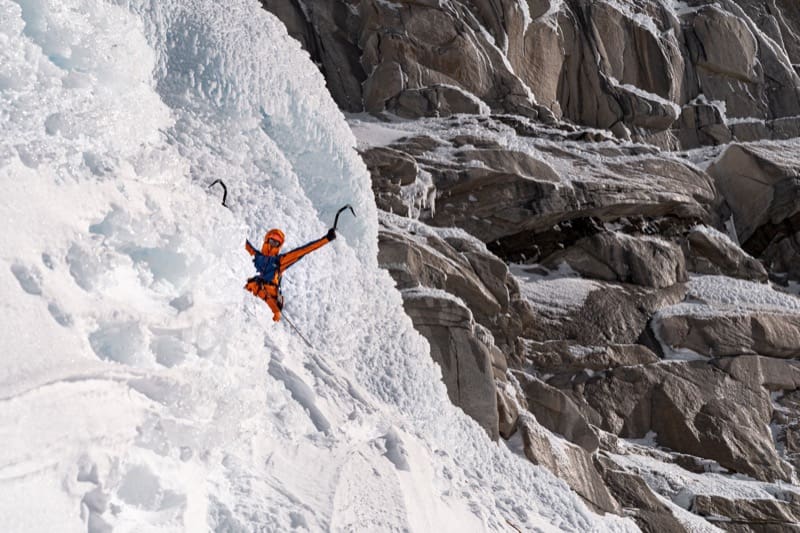
We could not let go of the fact that the northeast face of Cerro Cachet was still unclimbed. A few days later there was the prospect of stable weather for several days and we started our mission Cachet. After several hours of walking across the Nef glacier to the foot of the wall, we had to sit out the bad weather in our ABC tent on the second day. But it started on the third day: Our route led over an icy ramp up to a pass with rime ice, where after a short abseil and a counter-ascent we came directly under the 600 meter high headwall. A vertical and wild line of ice marked the logical line, but after climbing one pitch we had to turn left into the rock. The sun caused more ice fall than we would have liked. However, pitch after pitch, we found a climbable and objectively safe route through very beautiful and exciting mixed terrain. The most difficult lengths - we classified them with M7 + - we were able to secure with friends and normal hooks. However, a few pitches led over thin and steep ice sheets - the cavities underneath required solid nerves.
Be the first over the northeast wall on Cerro Cachet
After ten hours of climbing through the 600 meter high ice and rock face, we finally overcame the summit guard. A thick sea of fog lay over the inland ice, with a light summit ridge in front of us. It was shortly after 18.00 p.m. when we finally stood on top of the main summit of Cerro Cachet and fell into each other's arms - not as the first rope team ever, but the first to reach the summit via the northeast face.
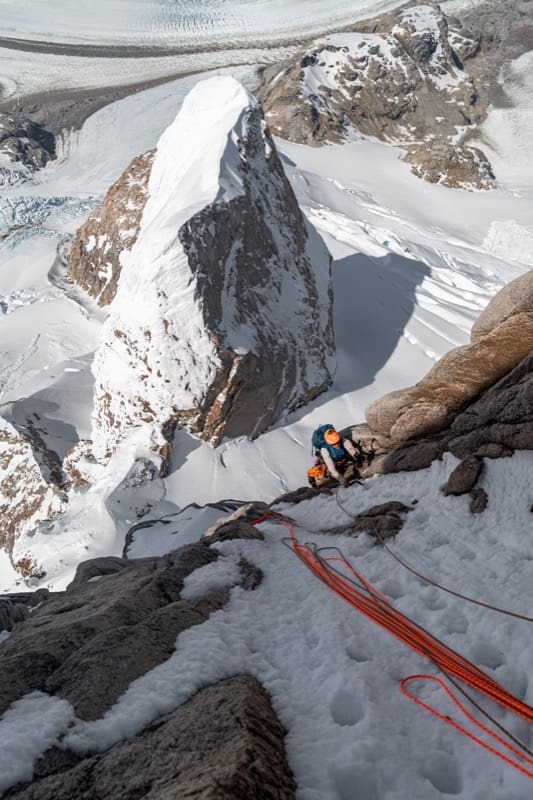
Homaje to Julian Zanker and other friends
Steph put a small doll on the summit. It was for his buddy and climbing partner Julian Zanker. Julian was supposed to come on the expedition to Patagonia, but in February 2019 he was killed in a fall in the north face of the Eiger. So in a way he had climbed the Cerro Cachet, for Steph it was a very emotional moment. And the name for this new route should also remind him of it: “Homenaje a los amigos perdidos”, we christened it, which means “in memory of lost friends”. What is meant are Ueli Steck (40), who died in Mount Everest in 2017, and 28-year-old Austrian David Lama, who was killed in an avalanche during an expedition in Canada in spring 2019, and Julian Zanker (28).
"We were literally bombed for an hour."
Apart from a few wild bulls that we had to avoid in the pampas, it only became critical once during our expedition - of all things, when we descended on the route that we named after our deceased friends. During the day, the sun had warmed the rocks around 300 meters above the entry ramp so much that rime ice the size of cars came off in the dark and we were literally bombarded for an hour. A rather uncomfortable loss of control, because there was no way out in the ramp - but luck was on our side. However, we had less luck after the long way back to the base camp. Our thoughts turned to a piece of Chilean beef that Gaucho Hector had given us. We saved it as a reward for a successful summit. The preparation of the entrecôte was topic number 1 on the descent. We had stored the meat chilled in a water bag in the river. The grill in the base camp was ready to go when we noticed the full extent of the disaster: The water bag had a hole, the meat was completely rotten and stank to itself. There was only one way out - "liquid chicken" - our last beers helped to forget the asado that had escaped.
Expedition facts
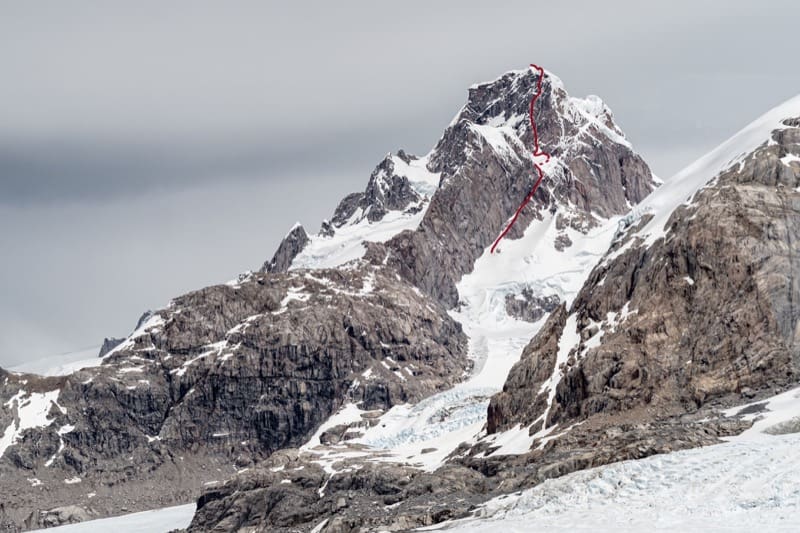
Period: 3.11. until December 15.12.2019th, XNUMX
Participants: Stephan Siegrist (48), Nicolas Hojac (27), Lukas Hinterberger (26), Tobias Hatje (55)
Cerro Cachet northeast wall: approx. 2.700 m, difficulty M7 +, 1500 m ascent from Nef Glacier varied, demanding mixed climbing route (first ascent)
Cerro Largo: 2.799 m, 23 km ascent over the Nef Glacier, 2500 m ascent from BC with ice climbing passage on the ice mushroom. 2. Ascent
Cerro Palomar: around 1800 m of challenging trekking mountain / panoramic mountain (first ascent)


